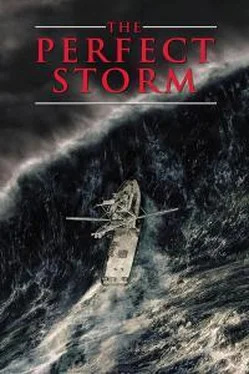Sebastian Junger - The Perfect Storm
Здесь есть возможность читать онлайн «Sebastian Junger - The Perfect Storm» — ознакомительный отрывок электронной книги совершенно бесплатно, а после прочтения отрывка купить полную версию. В некоторых случаях можно слушать аудио, скачать через торрент в формате fb2 и присутствует краткое содержание. Жанр: Триллер, Проза. Описание произведения, (предисловие) а так же отзывы посетителей доступны на портале библиотеки ЛибКат.
- Название:The Perfect Storm
- Автор:
- Жанр:
- Год:неизвестен
- ISBN:нет данных
- Рейтинг книги:3 / 5. Голосов: 1
-
Избранное:Добавить в избранное
- Отзывы:
-
Ваша оценка:
- 60
- 1
- 2
- 3
- 4
- 5
The Perfect Storm: краткое содержание, описание и аннотация
Предлагаем к чтению аннотацию, описание, краткое содержание или предисловие (зависит от того, что написал сам автор книги «The Perfect Storm»). Если вы не нашли необходимую информацию о книге — напишите в комментариях, мы постараемся отыскать её.
The Perfect Storm — читать онлайн ознакомительный отрывок
Ниже представлен текст книги, разбитый по страницам. Система сохранения места последней прочитанной страницы, позволяет с удобством читать онлайн бесплатно книгу «The Perfect Storm», без необходимости каждый раз заново искать на чём Вы остановились. Поставьте закладку, и сможете в любой момент перейти на страницу, на которой закончили чтение.
Интервал:
Закладка:
A good, worried crew starts by dogging down every hatch, porthole, and watertight door on the boat. That keeps breaking waves from busting things open and flooding the hold. They check the hatches on the lazarette, where the steering mechanism is housed, and make sure they're secure. A lot of boats founder when the lazarette floods. They check the bilge pump filters and fish out any debris floating in the bilgewater. They clear everything off the deck—fishing gear, gaff pikes, oil slickers, boots—and put them down the fishhole. They remove the scupper plates so the boat can clear her decks. They tighten the anchor fastenings. They double-lash the fuel and water barrels on the whaleback. They shut off the gas cocks on the propane stove. They lash down anything in the engine room that might break loose and cause damage. They press down the fuel tanks so that some are empty and others are as full as possible. That reduces something called free surface effect—liquid sloshing around in tanks, changing the center of gravity.
Some boats pay one crew member a bit extra to oversee the engine, but the Andrea Gail doesn't have such a position; Billy takes care of it himself. He climbs down the engine room companionway and runs through the checklist: engine oil, hydraulics, batteries, fuel lines, air intakes, injectors. He makes sure the fire and high-water alarms are on and the bilge pumps are working. He tests the backup generator. He hands out seasick pills. If one of the steel birds is out of the water, he puts it back in. He fixes his position on the chart and calculates how the weather will affect his drift. He reckons their course in his head in case a wave takes out their electronics. He checks the emergency lighting. He checks the survival suits. He checks the photos of his daughters. And then he settles down to wait.
So far the weather has been overcast but calm, light winds out of the northwest and a little bit of sea. Before the Portland Gale of 1898, one captain reported that it was "the greasiest evening you ever saw," and a few hours later 450 people were dead. It's not quite that calm, but almost. The wind hovers around ten knots and a six-foot swell rolls lazily under the boat. The Andrea Gail passes just north of Albert Johnston during the night, and by dawn they've almost made the western edge of the Banks, around 52 degrees west. They're halfway home. Dawn creeps in with a few shreds of salmon-pink sky, and the wind starts to inch into the southeast. That's called a backing wind; it goes counterclockwise around the compass and usually means bad weather is coming. A backing wind is an ill wind; it's the first distant touch of a low-pressure system going into its cyclonic spin.
Then another weather fax comes in:
HURRICANE GRACE MOVING WILL TURN NE AND ACCELERATE. DEVELOPING DANGEROUS STORM MOVING E 35 KTS WILL TURN SE AND SLOW BY 12 HOURS. FORECAST WINDS 50 TO 65 KTS AND SEAS 22 TO 32 FEET WITHIN 400 NM SEMICIRCLE.
It reads like an inventory of things fishermen don't want to hear. An accompanying chart shows Hurricane Grace as a huge swirl around Bermuda, and the developing storm as a tightly jammed set of barometric lines just north of Sable Island. Every boat in the swordfish fleet receives this information. Albert Johnston, south of the Tail, decides to head northwest into the cold water of the Labrador Current. Cold water is heavier, he says, and seems to lay better in the wind; it doesn't produce such volatile seas. The rest of the sword fleet stays far to the east, waiting to see what the storm does. They couldn't make it into port in time anyway. The Contship Holland, a hundred miles south of Billy, heads straight into the teeth of the thing. Two hundred miles east, another containership, the Liberian-registered Zarah, also heads for New York. Ray Leonard on the sloop Satori has decided not to head for port; he holds to a southerly course for Bermuda. The Laurie
Dawn 8 keeps plowing out to the fishing grounds and the Eishin Maru 78, 150 miles due south of Sable Island, makes for Halifax harbor to the northeast. Billy can either waste several days trying to get out of the way, or he can stay on-course for home. The fact that he has a hold full of fish, and not enough ice, must figure into his decision.
"He did what ninety percent of us would've done—he battened down the hatches and hung on," says Tommy Barrie, captain of the Allison. "He'd been gone well over a month. He probably just said, 'Screw it, we've had enough of this shit,' and kept heading home."
THE Boston office of the National Weather Service occupies the ground floor of a low brick building along a gritty access road in back of Logan Airport. Heavy glass windows allow a tinted view of the USAir shuttle terminal and a wasteland of gravel piles and rebar. Weather Service meteorologists can look up from their radar screens and watch USAir jets taxi back and forth behind a grey jet-blast barrier. Only their stabilizers stick up above it; they cruise like silver sharks across a concrete sea.
Weather generally moves west-to-east across the country with the jet stream. In a very crude sense, forecasting simply means calling up someone to the west of you and asking them to look out their window. In the early days—just after the Civil War—the National Weather Service was under the auspices of the War Department, because that was the only agency that had the discipline and technology to relay information eastward faster than the weather moved. After the novelty of telegraph wore off, the Weather Service was shifted over to the Department of Agriculture, and it ultimately wound up in the Department of Commerce, which oversees aviation and interstate trucking. Regional Weather Service offices tend to be in very grim places, like industrial parks bordering metropolitan airfields. They have sealed windows and central air-conditioning. Very little of the air being studied actually gets inside.
October 28th is a sharp, sunny day in Boston, temperatures in the fifties with a stiff wind blowing off the ocean. A senior meteorologist named Bob Case is crisscrossing the carpeted room, consulting with the various meteorologists on duty that day. Most of them are seated at heavy blue consoles staring resolutely at columns of numbers—barometric pressure, dewpoint, visibility—scrolling down computer screens. Behind the aviation desk is a bank of hotline phones: State Emergency Management, Regional Circuit, and Hurricane. Twice a day the State Emergency Management phone rings and someone in the office sprints to pick it up. It's the state testing its ability to warn people of a nuclear strike.
Case is a fit, balding man in his mid-fifties. A satellite photo of a hurricane about to clobber the coast of Maryland hangs in his office. He is responsible for issuing regional forecasts based on satellite imagery and a nationwide system called the Limited Fine Mesh, a grid superimposed on a map of the country where the corners represent data-collection points. Twice a day hundreds of LFM weather balloons are released to measure temperature, dewpoint, barometric pressure, and windspeed, and relay the information back by theodolite. The balloons rise to 60,000 feet and then burst, allowing the instruments to float back to earth on parachutes. When people find them, they mail them back to the Weather Service. The data from the LFM, plus input from a thousand or so other ground sites around the country, is fed into huge Cray computers at the National Meteorological Center in Camp Springs, Maryland. The computers run numerical models of the atmosphere and then spit forecasts back out to regional offices, where they are amended by local meteorologists. Humans still "add value" to a forecast, as meteorologists say. There is an intuitive element to forecasting that even the most powerful computers cannot duplicate.
Since early the previous day, Case has been watching something called a "short-wave trough aloft" slide eastward from the Great Lakes. On satellite photos it looks like an S-curve in the line of clear dry air moving south from Canada. Cold air is denser than warm air, and huge, slow undulations develop along the boundary between them and roll eastward—on their side, as it were—much like an ocean swell. The undulation gets more and more pronounced until the "crest" gets separated from the rest of the warm front and just starts to spin around itself. This is called a cutoff low, or an occluded front. Air gets sucked in toward the center, the system spins faster and faster, and within hours you have a storm.
Читать дальшеИнтервал:
Закладка:
Похожие книги на «The Perfect Storm»
Представляем Вашему вниманию похожие книги на «The Perfect Storm» списком для выбора. Мы отобрали схожую по названию и смыслу литературу в надежде предоставить читателям больше вариантов отыскать новые, интересные, ещё непрочитанные произведения.
Обсуждение, отзывы о книге «The Perfect Storm» и просто собственные мнения читателей. Оставьте ваши комментарии, напишите, что Вы думаете о произведении, его смысле или главных героях. Укажите что конкретно понравилось, а что нет, и почему Вы так считаете.












